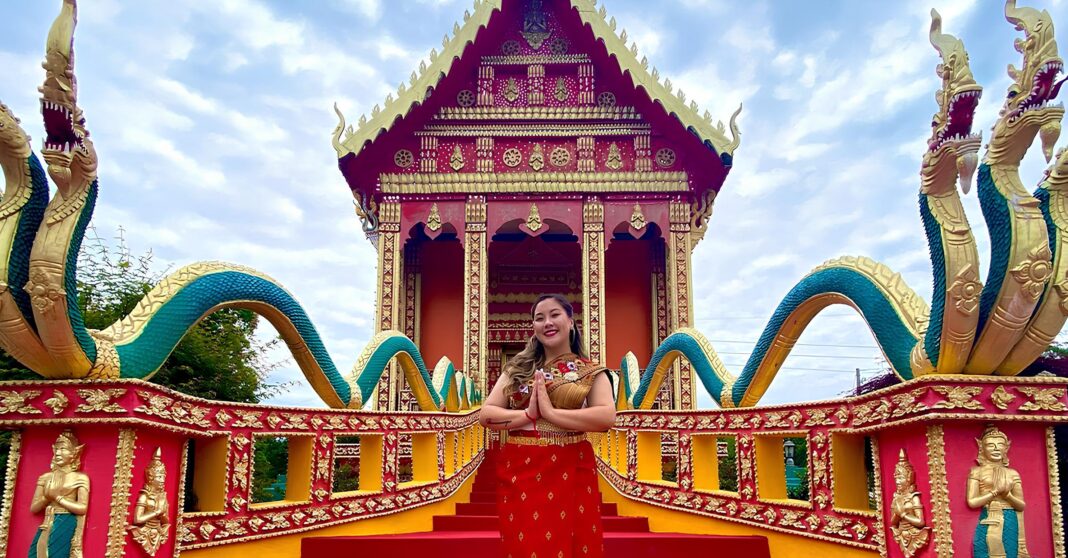When “Sa Tu”, or “Sathu,” is not only heard in the temple but echoed through pop rap music, it takes on new meaning.
For Hope ‘Hopii’ Thammavongsa, a 25-year-old Lao-American artist from Lawrenceville, Georgia, that word became an anthem of cultural pride.
Hope’s song has recently gained widespread popularity, particularly within the Lao-American community. The track has been welcomed for its fusion of Lao cultural elements with modern pop rap, resonating with listeners seeking representation and cultural pride in mainstream music.
Laos is a predominantly Buddhist country where the word Sa Tu (ສາທຸ) means “good” on a deep spiritual level. It’s traditionally used during blessings, often repeated three times to show respect for a person who can discipline body, speech, and mind.
“It’s like, I got to represent my Lao people from there and from here,” said Hope. “Because in America, in Georgia, where I grew up, they were always like, are you Korean? Are you Chinese? Everything but Lao.”
That feeling of being unseen pushed Hope to write a song where she could proudly represent her heritage. In the song’s bridge, she breaks it down:
“We gon say one thing, it’s got two syllables, it’s quite very simple. It’s like amen but just a tad Laotian, so say it loud, say it proud, say it with me: Sa Tu, Sa Tu, Sa Tu.”
The idea for the song came after Hope attended Sabaidee Fest in Los Angeles last year—a festival celebrating Southeast Asian culture, music, and identity.
“They’re my inspiration because if they’re in Laos doing music and I’m in Georgia, I can do music too, we can all do music,” she said.
That realization motivated her to finish the song, not knowing it would become a defining moment in her music career.
Because Sa Tu is considered a sacred word, traditionally used in temples or during blessings, Hope felt some hesitation about using it in a rap song. Still, she followed her instincts.
“There will be people out there that might not like it, but I really like it. And I’m really proud of what I did with the song and with the lyrics, trying to kind of explain to people who aren’t Laotian what Sa Tu is. Like it’s special,” she said.
Hope also hopes her music spreads joy and brings people of different backgrounds together.
“With my music, I want to show that an Asian person can be anywhere and everywhere just like anybody else. So I think that’s my purpose,” she stated.
The Journey
Hope’s love for music began at 15, singing with her uncle’s band. She started songwriting at 19 with her first song, Worthy, and by 23, she had released her debut album featuring four original tracks—marking her entry into the music world.
Navigating between two cultures—American and Lao—has deeply influenced her identity. While it can be difficult, Hope sees it as a strength.
“Being a Lao American, you really are living a double life. You have to balance American culture and then also being Laotian and trying to balance it. Sometimes I feel like I’m not Lao enough,” she said. “Sometimes I feel like I’m not American enough, but I’m grateful for both sides.”
The Process
Hope made a bold and creative choice by sampling the sound of a Lao parade at the start of her song. She opens it with the phrase “Heui Ya,” a term often heard in traditional Lao music, blending it seamlessly into a pop rap beat.
She spent a couple of hours writing the lyrics, but it took two months to find the perfect melody to bring the track to life.
The music video is currently in production and will be filmed in four locations, each with its own atmosphere. The first shoot takes place at Wat Lao Buddha Khanti in Snellville—the temple where Hope grew up. For this scene, she’ll be wearing a traditional Lao outfit.
Two more scenes will be filmed in different local parks, and the final scene will be at her grandmother’s house. Hope shared how much her family’s support has meant to her.
Though Hope lives far from her parents’ homeland, Lao traditions remain central to her life. Every year, she and her family celebrate Lao New Year together.
“I honestly wouldn’t be here if they didn’t come from Laos to America,” Hope said.
In Georgia, the Lao community celebrates with water fights, good food, shopping, and family time.
The next morning, Hope and her family take part in Tak Baat—giving alms to monks as part of the traditional celebration.



